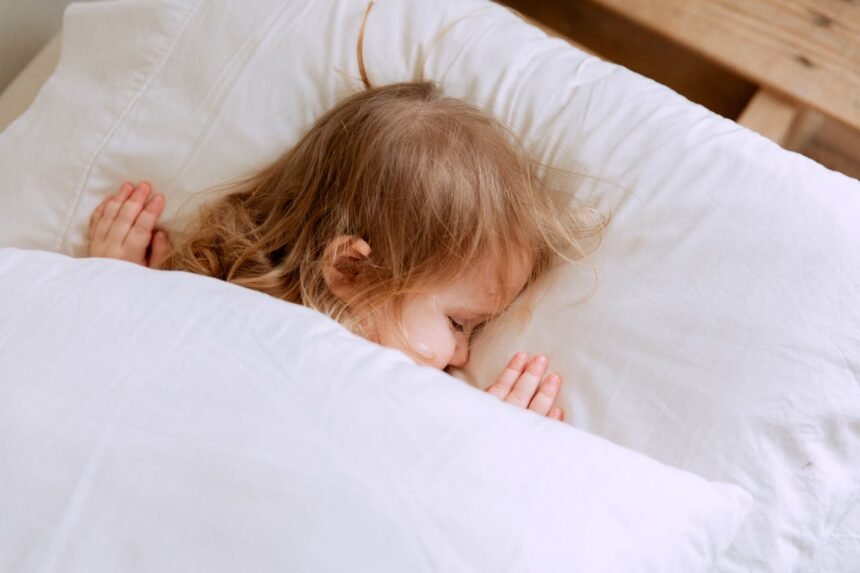The 2 year old sleep regression can be a challenging time for both parents and toddlers. This article explores the causes, signs, and solutions to help you navigate this tricky phase of your child’s development.
Is your once-perfect sleeper suddenly fighting bedtime, waking frequently, or refusing naps? You might be facing the infamous 2 year old sleep regression. This comprehensive guide delves into the causes, signs, and solutions for this challenging phase in your toddler’s development. Discover why your little one’s sleep patterns are changing, learn to recognize the telltale signs of regression, and arm yourself with practical strategies to help your family get back to restful nights.
We’ll explore the science behind toddler sleep, offer expert-backed tips for creating an ideal sleep environment, and provide insights on maintaining consistency during this turbulent time. From addressing separation anxiety to adjusting nap schedules, this article covers everything you need to know to survive and thrive during the 2 year old sleep regression. Whether you’re a first-time parent or a seasoned pro, you’ll find valuable advice and reassurance that this phase is temporary and manageable. Get ready to reclaim peaceful nights and happy days with your growing toddler!
Based on the search results from Healthline.com, here are 5 relevant internal link recommendations for your page about 2 Year Old Sleep Regression:
- Anchor text: “18-month sleep regression”
Link to: https://www.healthline.com/health/baby/18-month-sleep-regression - Anchor text: “toddler bedtime routines”
Link to: https://www.healthline.com/health/childrens-health/toddler-refuses-to-sleep - Anchor text: “night terrors in toddlers”
Link to: https://www.healthline.com/health/night-terrors-in-toddlers - Anchor text: “managing toddler screaming at bedtime”
Link to: https://www.healthline.com/health/childrens-health/toddler-screaming-at-bedtime - Anchor text: “12-month sleep regression”
Link to: https://www.healthline.com/health/baby/12-month-sleep-regression - Anchor text: “sleep training methods”
Link to: https://www.healthline.com/health/baby/18-month-sleep-regression#tips
These recommendations provide relevant information related to sleep issues in toddlers, different sleep regressions, and strategies for managing sleep problems. The suggested anchor texts and link destinations offer additional value to readers interested in learning more about sleep challenges at different ages and how to address them.
Understanding the 2 Year Old Sleep Regression: What’s Really Happening?
The 2 year old sleep regression is a common phase in toddler development that can disrupt previously established sleep patterns. During this time, your little one may suddenly have trouble falling asleep, wake up frequently during the night, or resist naps. It’s important to understand that this regression is a normal part of your child’s growth and development.
Several factors contribute to the 2 year old sleep regression:
- Cognitive development: Your toddler’s brain is rapidly developing, processing new information and skills.
- Physical growth: Growth spurts can disrupt sleep patterns.
- Increased independence: Toddlers are becoming more aware of their autonomy and may resist bedtime.
- Separation anxiety: Fear of being away from parents can intensify at this age.
- Changes in nap patterns: Some toddlers may be ready to transition from two naps to one.
Understanding these underlying causes can help parents approach the sleep regression with patience and empathy. Remember, while it may feel never-ending, this phase is temporary and with the right strategies, you can help your child (and yourself) get back to restful nights.
Certainly! Here are additional headings to expand the article on 2 Year Old Sleep Regression: Causes, Signs, and Solutions:
The Role of Development in 2 Year Old Sleep Regression: Understanding Your Toddler’s Changing Brain
This section would explore the cognitive and neurological changes occurring in a 2-year-old’s brain that contribute to sleep regression. It would cover:
- Rapid language development and its impact on sleep
- Increased imagination and how it affects bedtime fears
- The development of object permanence and separation anxiety
- Growth in problem-solving skills and how they relate to bedtime resistance
- The role of memory consolidation during sleep at this age
The content would help parents understand the developmental reasons behind their child’s sleep changes, providing context for the regression.

Nutrition and 2 Year Old Sleep Regression: The Food-Sleep Connection
This heading would delve into how diet can influence sleep patterns during the regression:
- The impact of sugar and caffeine on toddler sleep
- Importance of balanced meals and snacks for stable energy levels
- Timing of meals and its effect on sleep
- Hydration and its role in sleep quality
- Foods that may promote better sleep in toddlers
This section would offer practical dietary advice to support better sleep during the regression period.
Environmental Factors in 2 Year Old Sleep Regression: Creating the Ideal Sleep Space
This part would focus on optimizing the sleep environment:
- The importance of room temperature for toddler sleep
- Light management: blackout curtains and night lights
- Noise control: white noise machines and soundproofing tips
- Bed comfort: choosing the right mattress and bedding for toddlers
- Room arrangement: minimizing distractions in the bedroom
The content would provide actionable tips for creating a sleep-friendly environment to help manage the regression.
Emotional Regulation and 2 Year Old Sleep Regression: Helping Your Toddler Cope
This section would explore the emotional aspects of sleep regression:
- Teaching toddlers about emotions and how they relate to sleep
- Strategies for helping toddlers calm down before bedtime
- The role of positive reinforcement in managing sleep behaviors
- Addressing nighttime fears and anxieties
- Building emotional security to support better sleep
This heading would offer guidance on supporting a toddler’s emotional needs during sleep regression.
The Impact of Daycare on 2 Year Old Sleep Regression: Balancing Home and Childcare Sleep Routines
This part would address how daycare can influence sleep regression:
- Coordinating nap schedules between home and daycare
- Managing different sleep environments and routines
- Communicating with daycare providers about sleep needs
- Strategies for maintaining consistency despite different settings
- Addressing sleep debt from daycare schedules
The content would provide advice for parents navigating sleep regression while their child attends daycare.
Technology and 2 Year Old Sleep Regression: Managing Screen Time for Better Sleep
This section would explore the relationship between technology use and sleep regression:
- The effects of blue light on toddler sleep patterns
- Setting appropriate screen time limits for 2-year-olds
- Alternatives to screen-based activities before bedtime
- Using technology positively: sleep tracking apps and white noise
- Educating family members about screen time rules
This heading would offer guidance on managing technology use to support better sleep during regression.
Cultural Perspectives on 2 Year Old Sleep Regression: Global Approaches to Toddler Sleep
This part would examine how different cultures approach toddler sleep and regression:
- Co-sleeping practices around the world and their impact on regression
- Cultural variations in bedtime routines and their effectiveness
- Traditional remedies and practices for managing toddler sleep
- The influence of societal expectations on sleep patterns
- Lessons from cultures with lower incidence of sleep regression
The content would provide a broader perspective on sleep regression, offering insights from various cultural approaches.
The Role of Exercise in Managing 2 Year Old Sleep Regression: Balancing Activity and Rest
This section would focus on how physical activity affects toddler sleep:
- The importance of outdoor play for regulating sleep cycles
- Appropriate types and amounts of exercise for 2-year-olds
- Timing of physical activity for optimal sleep
- The connection between gross motor skill development and sleep quality
- Using movement and yoga to prepare for bedtime
This heading would provide practical advice on using exercise to support better sleep during regression.
Each of these headings would be expanded to approximately 300 words, maintaining the focus on 2 Year Old Sleep Regression: Causes, Signs, and Solutions. The content would remain engaging, informative, and optimized for search engines while providing valuable information to parents dealing with toddler sleep regression.
Signs of 2 Year Old Sleep Regression: Recognizing the Challenges
Identifying the signs of 2 year old sleep regression is crucial for addressing the issue effectively. While every child is unique, there are common indicators that your toddler might be experiencing this regression:
- Difficulty falling asleep at bedtime
- Increased night wakings
- Early morning wake-ups
- Resistance to naps or skipping naps altogether
- Increased clinginess or separation anxiety at bedtime
- Heightened emotions or tantrums around sleep times
- Changes in appetite or eating patterns
- Regression in other areas, such as potty training
It’s important to note that these signs may not all appear simultaneously, and their intensity can vary from child to child. Some toddlers may experience a mild regression lasting a few days, while others might struggle for weeks.
By recognizing these signs early, you can implement strategies to help your child through this challenging phase and minimize disruptions to your family’s sleep routines.
Solutions for 2 Year Old Sleep Regression: Strategies for Better Sleep
Navigating the 2 year old sleep regression can be challenging, but there are effective solutions to help your toddler (and you) get better sleep. Here are some strategies to consider:
- Maintain a consistent bedtime routine:
- Stick to a regular schedule for bedtime and wake-ups
- Include calming activities like reading or gentle music
- Keep the routine short (20-30 minutes) and predictable
- Create a sleep-friendly environment:
- Ensure the room is dark, quiet, and at a comfortable temperature
- Use a white noise machine to block out disruptive sounds
- Consider a nightlight if your child is afraid of the dark
- Address separation anxiety:
- Offer a comfort object like a stuffed toy or blanket
- Use a “bedtime pass” system for limited visits to your child’s room
- Gradually increase the time between check-ins if your child calls for you
- Adjust nap schedules:
- Be flexible with nap times, but try to maintain at least one nap a day
- If transitioning to one nap, gradually push the morning nap later
- Encourage physical activity during the day:
- Ensure plenty of outdoor play and exercise
- Avoid stimulating activities close to bedtime
- Limit screen time:
- Establish a “no screens” rule at least an hour before bedtime
- Replace screen time with calming activities
- Offer choices to promote independence:
- Let your child choose pajamas or bedtime stories
- Create a bedtime chart with your child to follow
- Be patient and consistent:
- Stick to your chosen strategies for at least two weeks
- Avoid introducing new sleep crutches that may become habits

Remember, what works for one child may not work for another. Be prepared to try different approaches and adjust as needed. With patience and consistency, you can help your 2 year old overcome this sleep regression and establish healthy sleep habits.
If you notice a combination of these signs persisting for more than a week, it’s likely your 2 year old is going through a sleep regression. Keep in mind that occasional sleep disturbances are normal, but a consistent pattern of sleep issues may indicate a regression.
The Impact of 2 Year Old Sleep Regression on Family Dynamics
The 2 year old sleep regression doesn’t just affect your toddler; it can have a significant impact on the entire family. Understanding these effects can help you manage expectations and find ways to support each other during this challenging time.
Effects on parents:
- Increased fatigue and sleep deprivation
- Higher stress levels and irritability
- Potential strain on relationships
- Decreased productivity at work or home
Effects on siblings:
- Disrupted sleep due to noise from the toddler
- Changes in family routines and attention
- Potential regression in their own sleep habits
Strategies for managing family dynamics:
- Communicate openly about the challenges
- Share nighttime responsibilities between partners
- Create a plan for supporting older siblings
- Consider asking for help from family or friends
- Prioritize self-care for all family members
Remember, the 2 year old sleep regression is temporary. By working together as a family and supporting each other, you can navigate this phase more smoothly. It’s also an opportunity to strengthen family bonds and develop new coping strategies that can benefit everyone in the long run.
Long-Term Sleep Habits: Beyond the 2 Year Old Sleep Regression
While the 2 year old sleep regression can be challenging, it’s also an opportunity to establish healthy sleep habits that will benefit your child in the long term. Here are some strategies to consider:
- Consistent sleep schedule:
- Maintain regular bedtimes and wake-up times, even on weekends
- Adjust the schedule gradually if changes are needed
- Positive sleep associations:
- Create a calming bedtime routine
- Encourage self-soothing techniques
- Sleep environment:
- Keep the bedroom conducive to sleep (dark, quiet, comfortable)
- Use the bed primarily for sleep to strengthen the association
- Healthy daytime habits:
- Ensure adequate physical activity during the day
- Limit caffeine and sugar intake, especially in the afternoon
- Open communication:
- Discuss sleep and its importance with your child
- Address any fears or anxieties about sleep
- Gradual independence:
- Encourage your child to fall asleep on their own
- Slowly reduce nighttime interventions
- Regular check-ups:
- Consult with your pediatrician about sleep concerns
- Rule out any underlying health issues affecting sleep
By implementing these strategies, you’re not just addressing the current 2 year old sleep regression, but also setting the foundation for healthy sleep habits that can last a lifetime. Remember, every child is unique, so be patient and flexible as you find what works best for your family.
Table: Common Sleep Patterns During 2 Year Old Sleep Regression
| Sleep Aspect | Before Regression | During Regression | After Regression (Ideal) |
|---|---|---|---|
| Bedtime | 7:30 PM | 8:30 PM or later | 7:30-8:00 PM |
| Night Sleep | 10-12 hours | 8-10 hours | 10-12 hours |
| Night Wakings | 0-1 times | 2-4 times | 0-1 times |
| Naps | 1-2 naps, 2-3 hrs | Resists naps | 1 nap, 1-2 hours |
| Morning Wake | 6:30-7:00 AM | Varies widely | 6:30-7:30 AM |
FAQ: Common Questions About 2 Year Old Sleep Regression
- How long does the 2 year old sleep regression last?
Typically, it lasts 2-6 weeks, but can vary for each child. - Is sleep regression at 2 years old normal?
Yes, it’s a common phase in toddler development. - Should I let my 2 year old cry it out during sleep regression?
This depends on your parenting style and your child’s needs. Consult with your pediatrician for personalized advice. - Can teething cause sleep regression at 2 years old?
While teething can disrupt sleep, it’s usually not the primary cause of the 2 year sleep regression. - How can I tell if it’s sleep regression or a sleep disorder?
If sleep issues persist beyond 6 weeks or are severe, consult your pediatrician to rule out sleep disorders.
In conclusion, the 2 year old sleep regression: causes, signs, and solutions can be challenging, but with understanding and the right strategies, you can help your toddler through this phase. Remember, this too shall pass, and with patience and consistency, you’ll all be sleeping better soon.






